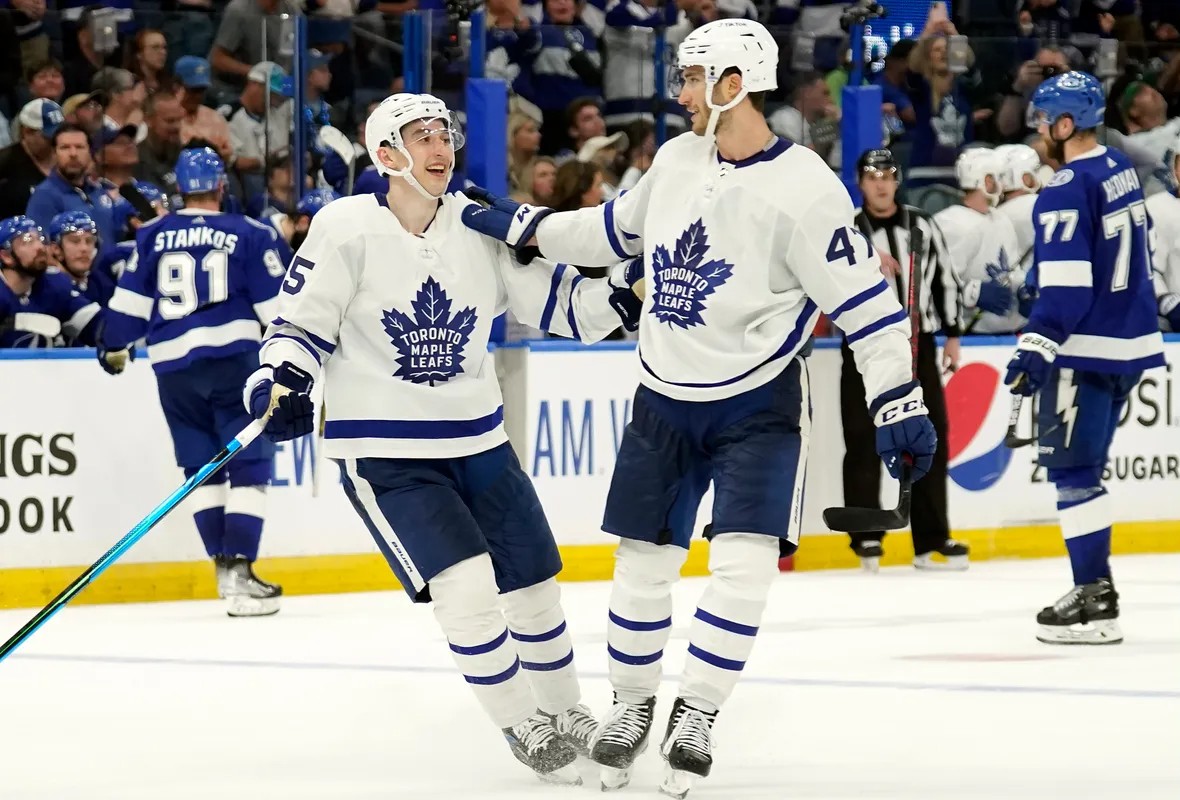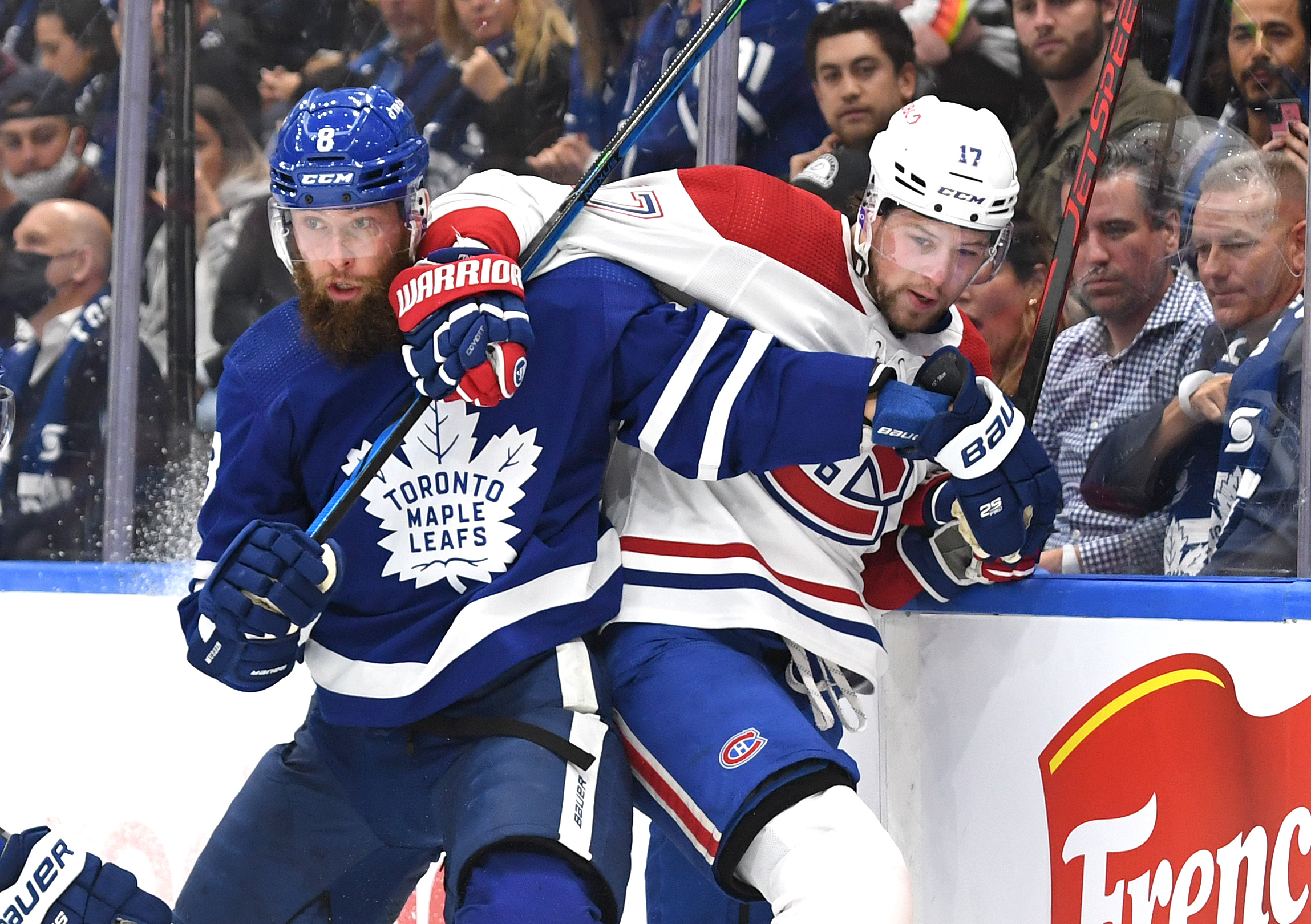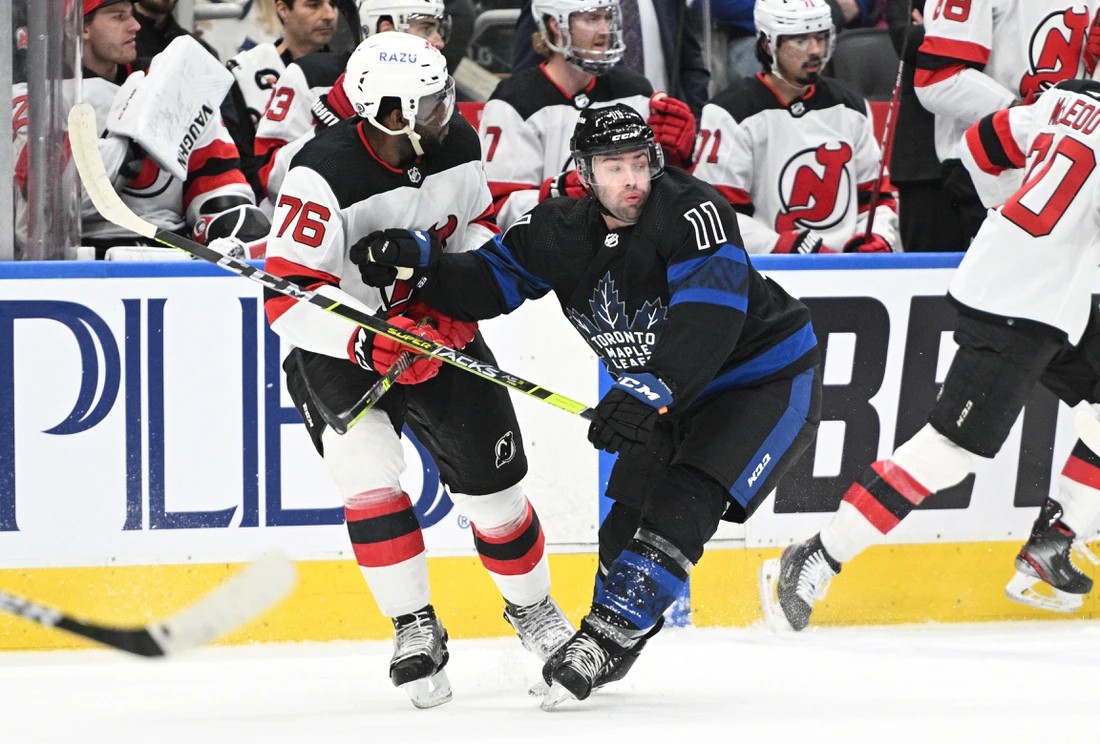As the dust has settled following yet another short postseason for the Maple Leafs, clearer minds are starting to ask what’s next for the organization after a franchise record in regular-season points and a sixth-straight first-round playoff loss.
Leading up to the NHL draft, I will break the organization down in a five-part series: assessing the current group (both the secondary and primary cores), previewing the draft, sizing up free agency, and finally, evaluating the current coaching staff (along with special teams). Part 1 concerns the secondary core and depth of the team.
In the instant aftermath of the defeat to the Lightning, there were a lot of strong opinions arguing to either run it back or blow the team up. As usual, the right answer likely lies somewhere in the middle.
When asked about running it back with the core, Kyle Dubas left the door more ajar than he ever has before:
“I do believe in the group. That said, with every offseason, no matter what the end result was, we would look at the entire group. We will do that in the coming weeks and determine how we want to move ahead.”
That is a far cry from his staunch defense of core players (particularly Mitch Marner) or flat-out declaring William Nylander is going nowhere as long as he’s the General Manager.
Dubas did a good job of assembling a strong team this past season, and it’s fair and reasonable to suggest he should stay at the helm. But an unwillingness to even entertain the notion of major moves this offseason is a fireable offense.
There seems to be an odd notion out there that if the Leafs make a major move, they will lose the trade significantly. But all of their top players are coming off of huge seasons and respectable playoff performances. They are also all under contract for multiple seasons. Those are not traditionally the types of players that net pennies on the dollar in a trade.
The Leafs should not move anyone for the sake of simply making moves, but there is absolutely a conversation to be had about shaking up the roster to improve the defense, goaltending, or to give the forward group a different look. There is only one Leaf player who is untouchable. For everyone else, they should at least be open to a conversation – depending on the offer, of course.
Now, if I was putting money on it, I would say nobody of significance will be traded, but staying open to the possibility is crucially important at this point. There is a path to running it back and moving out other money to fill out the roster, but every avenue has to be explored – which I think Dubas is more aware of than ever before, or at least is more willing to pay lip service to publicly.
Any offseason discussion for these Leafs has to start with goaltending. Last year’s starter (and All-Star), Jack Campbell, is an unrestricted free agent. The only goalie under contract with any sort of NHL resume is Petr Mrazek. Erik Kallgren and Joseph Woll both flashed promise at times last season, but any sort of combination of the three of those goalies to start the season would be an extremely disappointing approach – the type of decision that absolutely ends in the GM getting fired if it were to backfire.
The direction taken at the netminding position is the biggest question on the roster. The Leafs have a group of top forwards returning. Their defense is arguably set unless they choose to shake it up (more on that below). The decisions made in net could cut heavily into their available money, prospect pool, and/or tradeable NHL player options.
The Leafs have 16 NHL players (including Petr Mrazek, but not including Erik Kallgren) signed at the moment and roughly $8 million in cap space give or take (depending on who we swap in/out) to fill out the final five or six roster spots. If we include a potential Mrazek buyout, it would open up just under $2.8 million in additional cap space (overall, it’s a quite feasible – and tempting – option).
All of Pierre Engvall, Ondrej Kase, Timothy Liljegren, and Rasmus Sandin are restricted free agents. Re-signing all of them would significantly cut into the remaining cap space or possibly (probably?) use up all of it.
There is also the list of unrestricted agents: Ilya Mikheyev, Colin Blackwell, Ilya Lyubushkin, and Jack Campbell. They can’t possibly bring them all back.
The questions extend beyond goaltending – namely, how will they fill out the bottom six, and do they have the appetite to add a defenseman of note?
Let’s look at it in more detail while attempting to remain honest about the roster and where the team sits at the present day.
The secondary-scoring problem at playoff time

The most recent iteration of the team’s roster held up well against a strong Tampa Bay team, but looking forward, there are a ton of question marks. It’s not about making a knee-jerk reaction to another playoff defeat; it’s about asking whether it’s feasible to run the group back by and large based on the current roster.
There are notable issues to take a hard look at. Three of the team’s four top defensemen in terms of ice-time in the playoffs are on the wrong side of 30 and are at best stagnating or perhaps even declining. As of right now, the roster of signed players stacks up like so:
Bunting – Matthews – Marner
Kerfoot – Tavares – Nylander
Robertson – Kampf – Abruzzese
Clifford – Steeves – Simmonds
Rielly – Brodie
Muzzin – Holl
Giordano
Petr Mrazek
In the playoffs, the Leafs’ bottom six – which included some combination of Ilya Mikheyev, Pierre Engvall, David Kampf, Ondrej Kase, Colin Blackwell, Jason Spezza, Kyle Clifford, and Wayne Simmonds – combined for three goals, and Mikheyev scored two empty netters. By comparison, Tampa Bay’s bottom six of Ross Colton, Nick Paul, Branden Hagel, Corey Perry, Pierre-Edouard Bellemare, and Patrick Maroon combined for 10 goals (no empty netters). However we slice it, the gap in depth scoring was significant.
In the playoff previous, the Leafs’ bottom six contributed four goals – Jason Spezza scored three of them, and one came when he moved into the top six. Joe Thornton scored the other on the power play. In the year before against Columbus, the only bottom-six forward (in terms of time on ice) to score at all was Nick Robertson.
This has been a consistent problem for three years running under this management regime. The difference this past playoff is that the top forwards were full marks for producing. While we hear all the time that a team lives and dies by its stars – which is largely true – when the gap is this tight between top teams, every single player matters.
In previous years, the Leafs loaded the first line with ice time – because they had nothing in the bottom six – and it gassed their top players. This year, they did have some substance in the bottom six – specifically, the third line was legitimately solid – but they weren’t able to provide much offensively. The fourth line was generally a nonfactor outside of taking penalties.
Due to the salary structure of the team, the stars receive the most attention in this market, but there is a secondary core that really deserves attention when it comes to the Leafs and their options this offseason.
The “secondary core” and the looming offseason decisions

Right now, the mix in the secondary core includes Michael Bunting, Alex Kerfoot, TJ Brodie, Jake Muzzin, and arguably David Kampf. It has included Ilya Mikheyev in the past (and even Justin Holl at one point).
This is the group that is the biggest question mark for the Leafs. When we hear comparisons to other teams that finally made it over the hump while keeping their primary core together, it is the secondary core that has evolved and pushed them over the top.
Washington ran a core featuring Alex Ovechkin, Nik Backstrom, John Carlson, Dmitri Orlov, and Braden Holtby for six years before finally winning in year seven. The secondary core at the beginning of their window featured players such as Alex Semin, Marcus Johansson, Brooks Laich, Dennis Wideman, and Troy Brouwer. When they eventually won, the secondary group was completely replaced by Evgeny Kuznetsov, Tom Wilson, TJ Oshie, Lars Eller, and Matt Niskanen.
By the time Tampa Bay eventually broke through, the Lightning had added players like Yanni Gourde, Blake Coleman, and Barclay Goodrow, while Erik Cernak and Mikhail Sergachev matured into significant contributors. If we want to look at the Tampa Bay teams from the beginning of the decade that featured Steven Stamkos and Victor Hedman (along with players like Alex Killorn, Ondrej Palat, and Tyler Johnson) as the original core, by the time they won, Brayden Point and Alexei Vasilevskiy were developed as well. In essence, they added to their primary core and their secondary core.
When Pittsburgh won back-to-back Cups, it was in large part the result of finally rebuilding their core around Sidney Crosby, Evgeni Malkin, and Kris Letang. It wasn’t because those players forgot how to play hockey for a few seasons and then remembered how to again.
That is partly what makes the past few exits particularly painful in Toronto. The Leafs bought aggressively to add to their secondary group by adding Muzzin, Brodie, Giordano, Nick Foligno, and making the Nazem Kadri for Tyson Barrie and Alex Kerfoot trade. They moved a plethora of draft picks along the way and got rid of players such as Kasperi Kapanen and Andreas Johnsson for cap purposes (among other reasons).
Zach Hyman was so good he priced himself out of Toronto. John Tavares was in his prime and a legitimate line driver when they signed him, too. Now? I’m not so sure that’s still the case. At some point, Tavares is going to move into the secondary core of players as he declines. Winning absolutely nothing to this point with their secondary group is disappointing, to say the least.
Muzzin is becoming injury-prone, and another notable injury impacted his play when he was in the lineup this past season. It’s fair to wonder how much he has left. Brodie put together a solid season and just turned 32 with two years on his contract; he is probably in the “safe and steady” category as he has generally stayed healthy and can still skate.
Mikheyev has four points in 19 career playoff games – all of which came in this past playoff – and two of those four points were empty-net goals. Kerfoot has one even-strength goal in 19 playoff games as a Leaf and three total even-strength playoff goals in 37 career playoff games. You could argue a case for getting rid of more than just Mikheyev this summer.
If there is a taker for Muzzin – who has two years left – that is worth exploring provided it doesn’t cost the team assets (retention, prospects, or picks). If it’s not possible, the Leafs could conceivably consider moving Brodie instead (which is partly made possible by signing Mark Giordano for next to nothing; plus, they have two young defensemen in need of ice time). It should be noted that Brodie and Muzzin both have full no-trade clauses right now, so dealing either could be tricky.
Alex Kerfoot makes a lot of money for a player who, while useful, always ends up becoming a second/third line tweener that plays on the wing while chipping in as a penalty killer. Clearing one or both of those deals suddenly opens the door to become a very aggressive buyer. They would essentially double their cap space.
As we all know, there are really two versions of a team over the course of a season: the team before the trade deadline, and the team after. The pre-deadline Leafs have one of the best lines in the league and one of the best power plays in the league (they will still need a goalie). They can roll with them during the first half of the regular season and win more than enough to make the playoffs while banking cap space for the deadline.
And then there is the post-deadline period, where everything settles into place after the contenders have bought assets (and the Leafs are buyers as long as they have this core intact). How their bets pan out (Marlies, prospects, bargain-bin adds, other free agent signings, etc.) informs their trade deadline strategy – to say nothing of how the game changes as the course of the 82 games and then the playoffs play out.
With that in mind, the Leafs have a number of players worth auditioning for larger roles. There are a few options, and they likely need to be afforded some rope in the form of game action at the start of the season in order to make a case for whether or not they could be viable contributors at playoff time.
Last season, Timothy Liljegren became a mainstay before he was sat following the first game of the playoffs. He should be afforded an opportunity to see how high he can move up the lineup. If all goes well, he could be a regular playoff contributor come playoff time. As a pending RFA, he would be an interesting candidate for a long-term deal with a lower annual average. If the Leafs bridge him now, it will almost certainly come back to cost them.
On the flip side, there is Rasmus Sandin. He was having a solid season before he fell injured and was unable to get back into the lineup. This was the second season in a row he has played a limited number of games, and while there is a lot to like about the upside — and he should be counted into the roster to start — it would be much more reasonable to sign him to a bridge contract to see if he can string some healthy seasons together.
Signing both Sandin and Liljegren while potentially moving on from Muzzin gives the team all sorts of versatile options to play around with on the pairings while moving the two kids up to see what they can handle (and if they’re in over their head, the Leafs have veterans they can trust).
Last summer, the Leafs tried signing Jani Hakanpaa as a depth defenseman but he ultimately ended up in Dallas. In the offseason before that, Dubas successfully signed Zach Bogosian. It would not be surprising to see the Leafs attempt to add a veteran depth defenseman of that ilk to round out the unit should they move on from someone on the current roster (for example, should they trade Justin Holl instead of a more notable name like Muzzin).
At forward, they almost have to give Nick Robertson a real run to start the season. Turning 21 in September, he scored 16 goals in 28 AHL games in 2021-22. He represents one of their best opportunities to add a cheap goal-scoring option to their secondary core. He should receive looks in the first half of the season to try to make his mark. If he’s not up to it, the Leafs have a core that can more than hold the fort down. It’s a good position to be in for a young player hoping to make an impact.
The benefit of the Leafs’ top players in this regard cannot be overstated. They are going to rack up wins for the team in the regular season when they heat up. We’ve seen it time and time again. That allows the Leafs’ brass to insert journeymen, other bargain-bin signings, and potential Marlies graduates to see what they’re capable of. The team can win in spite of them if they really have to.
The internal options and pending RFAs up front

The abovementioned competitive advantage is one that should be leveraged further. It would be better to use the remaining cap space on one or two impact adds (a goalie and a forward) while filling out the roster with hungry young kids (rather than over-the-hill veterans, as they have for years now).
Alex Steeves, turning 22 in December, should certainly be a candidate coming off of 46 points in 58 game AHL rookie season. Notable contributions from young players like this on ELCs are the exact type of thing that opens up space to pay up for proven players they can trust and add to that secondary core.
Colin Blackwell also fit in well, adds some versatility, and if he could be signed for cheap, would make some sense to retain as a known quantity who can contribute while pairing with a potential Marlie and providing veteran support on the ice.
The Leafs have yet to be able to create a third line that can really score. When Sheldon Keefe moved Nylander there, he had hardly anyone to play with. Ilya Mikheyev did not produce in the playoffs, but he has still likely priced himself out of Toronto with his 32-goal regular season pace, leaving a notable hole to fill (for the regular season, anyway). They struck gold with Michael Bunting effectively replacing Zach Hyman last season, so it’s not out of the question, but it’s a tough ask nonetheless.
They could hypothetically try Nylander on the third line again, but it’s not a viable solution long-term if David Kampf (who is turning 27 and just had a career-high 26-point season) is his centerman. They’d have to add a center somehow.
There are also two RFAs of note. Pierre Engvall is coming off of a career season and another playoff where he left us wanting a whole lot more. Considering his progress, the uncertainty surrounding most of the rest of the bottom six, and his ability to pair up well with Kampf, bringing him back is understandable as long as the number is reasonable. But what will the number really be?
Flipping through the players on CapFriendly that signed around his age (26) and production (62 points in 168 games), a lot of the contracts were in the $2.5 – 3 million range. If that is the case – and that’s what the Leafs anticipate will happen – there’s a real argument to walk away altogether by not qualifying him. Could they sign a player instead for around $1.75-2 million and receive a similar overall contribution?
If they think Engvall is going to develop further and become a legitimate needle mover at playoff time, they would be wise to lock him into that type of money. If he’s strictly a bottom-six forward who can chip in 15 goals and pinch-hit on the penalty kill, they have to try to save a million there.
Ondrej Kase became a fan favourite when he did play, but he once again got hurt repeatedly, and when he did feature in the playoffs, he struggled. It’s unfortunate he can’t stay healthy, but I’d rather the Leafs use a roster spot to give a young player a chance (namely, the two mentioned above, and possibly even Nick Abbruzzese) than roll the dice that this will be the year that Kase finally stays healthy. Elliotte Friedman noted that there’s a chance that Kase’s arbitration award could spook the Leafs. He is a nice player when he plays, but it’s really tough to depend on him.
Saving space there and using it on better bets to play more games, coupled with saving space on promoting a few Marlies, gives the Leafs the sort of cap space to make a notable signing. It’s not the sexiest move, but it represents upside and gives them cap space to perhaps make one forward addition of note (and potentially another move of significance depending on whether Muzzin and Kerfoot are cleared off the books).
At the deadline, with the banked cap space, the team could add another player of significance. If they hit on even one young player stepping into a prominent role over the season, they’ve remade that secondary core on the fly, thereby (hopefully) better supporting the main core.
If they’re going to run back the primary core, the Leafs are going to need another quality forward to add to their secondary group.
In Part 2, we will take a look at the top six forwards and the main core, which certainly has question marks of its own.






























![New Leaf Anthony Stolarz on the opportunity in Toronto: “In Florida, I knew my role as a backup… Now, [Joseph Woll] and I are competing for starts… As a goalie, that’s all you can ask for” Anthony Stolarz, Stanley Cup win, now Maple Leaf](https://mapleleafshotstove.com/wp-content/uploads/2024/07/anthony-stolarz-sc-100x70.jpg)
